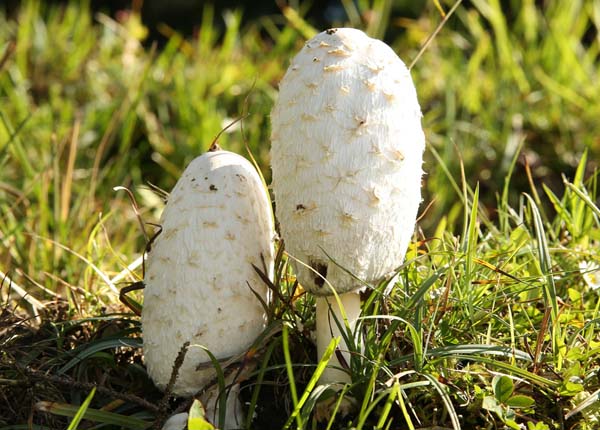How to use: Chicken of the woods is best suited for culinary purposes. They are the most popular substitutes in recipes that call for Chicken and other nonvegetarian varieties.
Where do they grow: Chicken of the woods grow in large groups on the stumps and trunks of Oak, Willow, Cherry, Sweet Chestnut, Yew, and on the wood of other hardwoods living or dead.
11. Enokitake:

Enokitake, also known as Lilly mushrooms, Nim Kim Châm in Vietnamese, Jingu in Chinese, and PaengiBeoseot in Korean, is found in the wild and cultivated. They are being cultivated for hundreds of years and are commonly used in culinary applications, often in soups and noodle bowls.
Other names: Flammulinavelutipes
Characteristics: CultivatedEnokitake looks like long strings, almost noodles like and have tiny, convex caps. They are thin and tightly packed in clusters and can grow up to twelve centimeters. Wild ones are different in appearance as they have shorter stems and larger caps, and their color ranges from slight orange to brown. These are rubbery and slightly sticky to touch.
Taste: Enokitakesare mild and have a slight fruity flavor. They are well known for their crispy and crunchy texture.
How to use: Commonly used in Japanese and Chinese cuisines, Enokitakes are usually added as textural enhancers to ramen bowls, soba noodles, hot pot soups, stir-fries, and stews.
Where do they grow: In the wild, enokitake grows in clusters on rotting wood, especially on the stumps of Chinese hackberry trees and mulberry, persimmon, and ash trees. Commercial varieties are cultivated in a dark carbon dioxide-rich environment to encourage the stems to stretch to become noodle-like, trying to reach the light.
12. Shaggy Mane:

Shaggy mane mushrooms are very common, widespread, wild mushrooms. They belong to the “Coprinus” genus and are called inky caps’ due to their unique auto digestion feature. As the name suggests, autodigestion is where the mushroom’s fruiting body melts into black, gooey liquid within a few hours of harvesting.
RELATED BEST 10 ON AMAZON:
| IMAGE | TITLE | TRENDS | SEE MORE |
|---|
 | Vintage Botanical Prints | Psychoactive Psychedelic Plants by Ink Inc. | Cannabis Coca Opium Poppy Tobacco Wormwood Grapes... | 2649.6 | MORE VIEW |
|---|
 | Sponsored Ad - The Native American Herbalist’s Bible [9 Books in 1]: Find Out Thousands of Herbal Remedies and Recipes, Gr... | 1989 | MORE VIEW |
|---|
 | National Audubon Society Field Guide to North American Mushrooms (National Audubon Society Field Guides) | 25550.4 | MORE VIEW |
|---|
 | Vintage Mushroom Poster Fungus Wall Collage Kit, Botanical Aesthetic Room Decor Pictures, Living Room Office Classroom Bed... | 1102.5 | MORE VIEW |
|---|
 | National Audubon Society Field Guide to North American Wildflowers--E: Eastern Region - Revised Edition (National Audubon ... | 3796.8 | MORE VIEW |
|---|
 | 437 Edible Wild Plants of the Rocky Mountain West: Berries, Roots, Nuts, Greens, Flowers, and Seeds | 2024 | MORE VIEW |
|---|
 | Mushrooms of the Northeastern United States and Eastern Canada (A Timber Press Field Guide) | 2876.4 | MORE VIEW |
|---|
 | Farmer's Market 2022 Wall Calendar | 2059.2 | MORE VIEW |
|---|
 | National Audubon Society Field Guide to North American Mushrooms (National Audubon Society Field Guides) | 25550.4 | MORE VIEW |
|---|
 | Our World in Pictures: Trees, Leaves, Flowers & Seeds: A visual encyclopedia of the plant kingdom | 14985.6 | MORE VIEW |
|---|
 | Floriography: An Illustrated Guide to the Victorian Language of Flowers | 13421.1 | MORE VIEW |
|---|
 | Mushrooms: How to Identify and Gather Wild Mushrooms and Other Fungi | 8822.4 | MORE VIEW |
|---|
 | How to Eat in the Woods: A Complete Guide to Foraging, Trapping, Fishing, and Finding Sustenance in the Wild | 5625.9 | MORE VIEW |
|---|
 | Mushrooms of the Pacific Northwest (A Timber Press Field Guide) | 4126.2 | MORE VIEW |
|---|
 | Peterson Field Guide To Mushrooms Of North America, Second Edition (Peterson Field Guides) | 4017.6 | MORE VIEW |
|---|
 | National Audubon Society Field Guide to North American Wildflowers--E: Eastern Region - Revised Edition (National Audubon ... | 3796.8 | MORE VIEW |
|---|
 | Encyclopedia of Plants and Flowers | 3539.1 | MORE VIEW |
|---|
 | National Audubon Society Field Guide to North American Trees--W: Western Region (National Audubon Society Field Guides) | 3369.9 | MORE VIEW |
|---|
Tips: "Amazon, Amazon Prime, the Amazon logo and Amazon Prime logo are trademarks of Amazon.com, Inc. or its affiliates". AS AN AMAZON ASSOCIATE, WE EARN AFFILIATE COMMISSIONS FROM QUALIFYING PURCHASES.
























